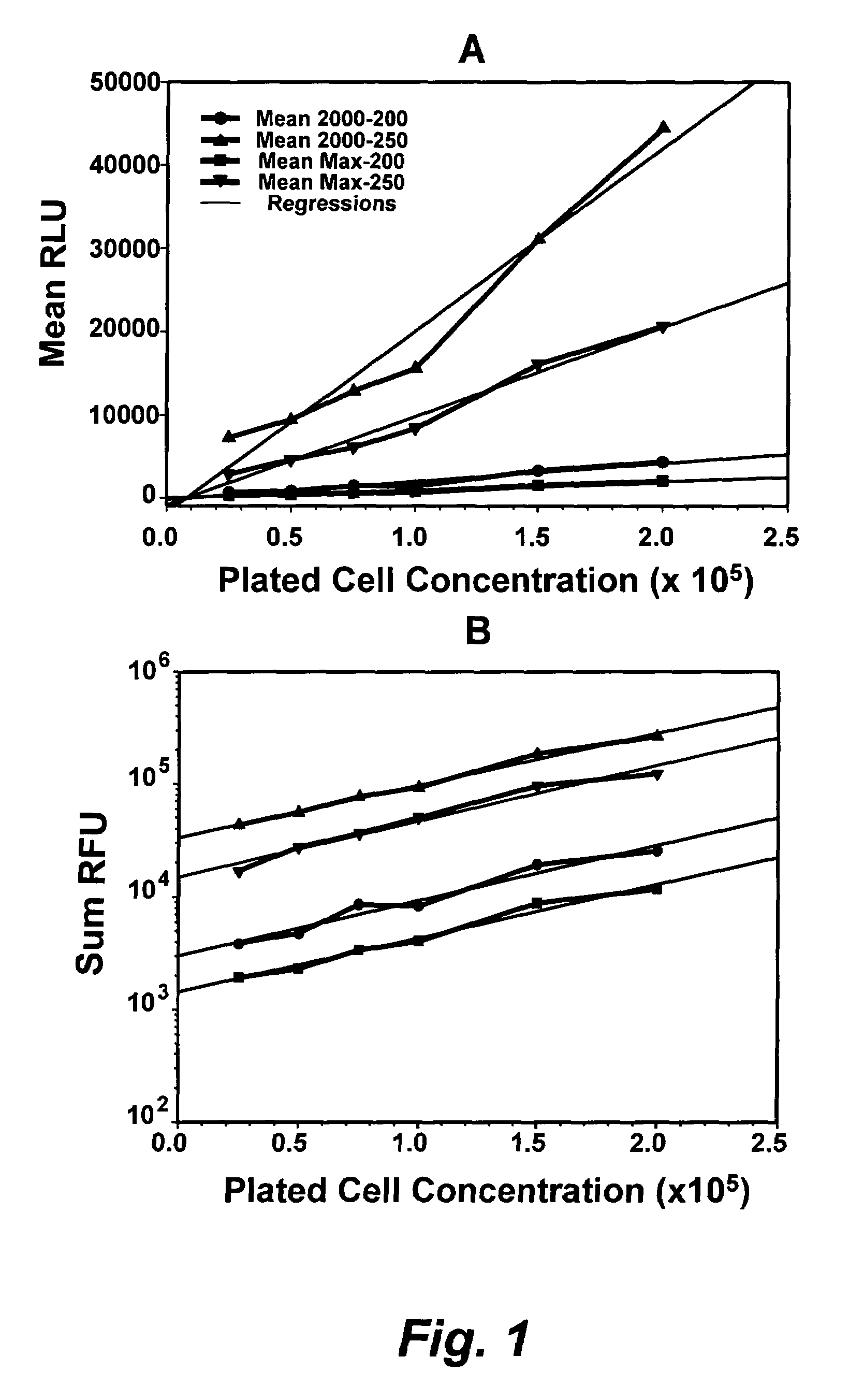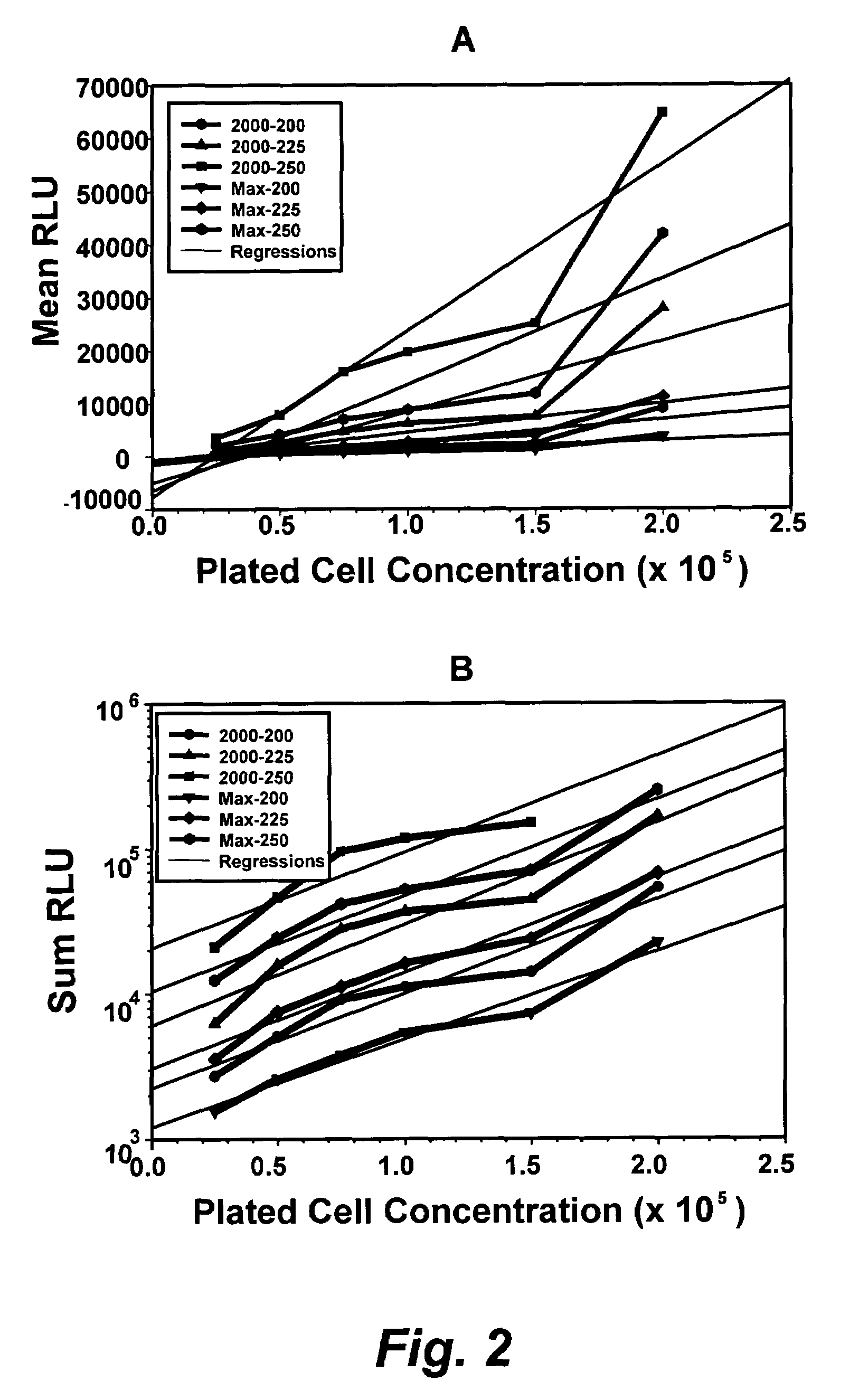High-throughput assay of hematopoietic stem and progenitor cell proliferation
a hematopoietic stem and progenitor cell technology, applied in the field of high-throughput assay methods, can solve the problems of poor predictive value of parameters, changes in the site of cell production, and patients in clinical trials that are often unpleasant and sometimes harmful effects
- Summary
- Abstract
- Description
- Claims
- Application Information
AI Technical Summary
Benefits of technology
Problems solved by technology
Method used
Image
Examples
example 1
Hematopoietic and Hematotoxicity Assay via Luminescence Output (HALO)
Step 1: Cell Preparation
[0155]The type of HALO kit used is determined according to which stem and / or progenitor cell populations are to be detected and whether for human or murine hematopoietic cells. If the kits of the present invention are defined for use with human cells, it can also be used to culture non-human primate (both rhesus and cynmologus primates) and canine hematopoietic cells. If the kits are defined for use with mouse cells, they can also be used to culture rat hematopoietic cells.
A. Murine or Rat Bone Marrow
[0156]1. Remove organs (femora or tibia) under aseptic conditions.[0157]2. Remove as much muscle from the bones as possible.[0158]3. Using a sterile sharp blade, first cut off the proximal (hip joint) end below the ball joint at right angles to the longitudinal length of the bone. Then cut off the distal end (above the patella or knee).[0159]4. Transfer sufficient medium to a tube so that it wil...
example 2
Measurement of the ATP Content of Incubated Hematopoietic Stem or Progenitor Cells
[0241]After the incubation time has elapsed, the reagents from the ViaLight HS™ kits (Lumitech) were prepared for use. If necessary, the number of cell clusters (aggregates) or colonies that had developed in the wells of the incubated 96-well plates could be counted under an inverted microscope to ensure that a correlation between the sum, or mean, of the ratio of clusters / colonies to the relative luminescence units (RLU) was obtained (see below).
[0242]All reagents were allowed to attain room temperature before use. The ATP luminescence-monitoring reagent was reconstituted as described by the manufacturers by adding 10 ml of the supplied buffer to the lyophilized reagent and waiting 15 mins. Alternatively, 1 ml of the buffer was used to reconstitute the reagent and the latter was then aliquoted into 1.5 ml microtubes and frozen while protected from light. Aliquots were then thawed and diluted to 1 ml f...
example 3
Hematopoietic Stem and Progenitor Cell Lines and Their Associated Cytokine Effectors
[0252]Hematopoietic stem and progenitor cells are induced to differentiate into hematopoietic cell subpopulations by exposure to one or more growth factors / cytokines, as shown in Table 3 below.
[0253]
TABLE 3DevelopmentPopulationStimulatory GrowthstageLineagePopulation nameabbreviationfactors and cytokinesStem cellNoneLong-term culture-LTC-ICStimulated by(Mostinitiating cellsmicroenvironmentalprimitive incellsvitro stemcell)Stem cellNoneColony-formingCFC-BlastFlt3L, SCF and IL-6(Verycell-Blastprimitive invitro stemcell)Stem cellNoneHigh proliferativeHPP-CFCIL-1, IL-3, IL-6, SCF,(Primitive inpotential colony-M-CSFvitro stemforming cellcell)Stem cellNoneColony-forming cellCFC-GEMMIL-3, IL-6, GM-CFC, G-(Most maturegranulocyte,CSF, EPO, and SCFin vitro stemerythroidand / or Flt3Lcell)macrophage,megakaryocyteProgenitorErythroidBurst-forming unit-BFU-EEPOErythroidIL-3 and EPOSCF and EPOIL-3, SCF and EPOProgeni...
PUM
 Login to View More
Login to View More Abstract
Description
Claims
Application Information
 Login to View More
Login to View More - R&D
- Intellectual Property
- Life Sciences
- Materials
- Tech Scout
- Unparalleled Data Quality
- Higher Quality Content
- 60% Fewer Hallucinations
Browse by: Latest US Patents, China's latest patents, Technical Efficacy Thesaurus, Application Domain, Technology Topic, Popular Technical Reports.
© 2025 PatSnap. All rights reserved.Legal|Privacy policy|Modern Slavery Act Transparency Statement|Sitemap|About US| Contact US: help@patsnap.com



